This is a brief 10 minute talk with slides, given to Lincoln University, Doctoral conference.
23 Feb 2022
It has images of beautiful paintings of the West coast of Scotland by Jon Schueler. Also a few of my own holiday photos too!
This is a brief 10 minute talk with slides, given to Lincoln University, Doctoral conference.
23 Feb 2022
It has images of beautiful paintings of the West coast of Scotland by Jon Schueler. Also a few of my own holiday photos too!
In June, I took a trip to Mallaig to investigate the places that the American artist had lived in , a small isolated bungalow at Mallaig Vaig (1957/58) and a converted schoolhouse called Romasaig (1970-75).
This is a photographic record of that trip.
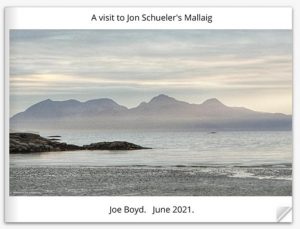
To see it, follow the link below.
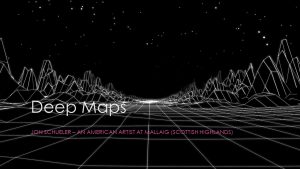
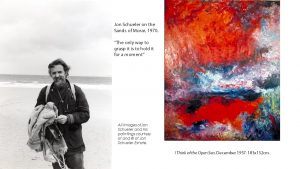
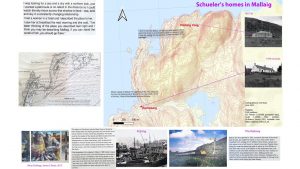
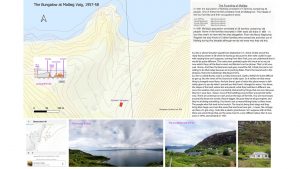
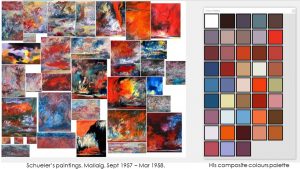
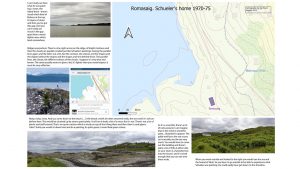
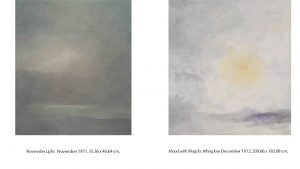
In the photograph, Jon Schueler (1916 – 1992), born in Milwaukee, with Swiss/German antecedents, stands on the empty ‘silver sands of Morar’. He has a warm smile. The faint outline of the Isle of Eigg is just visible on the horizon, at the right. Its distant and unique contour is an appropriate metaphor for Schueler’s life and work in Scotland.
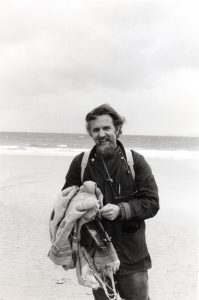
Jon Schueler on the Sands of Morar, 1970.[1]
“The only way to grasp it is to hold it for a moment”
When this photograph was taken, Schueler was at the beginning of his second major residency in Scotland. He was staying in Romasaig, a former schoolhouse near Mallaig that he had rented. He lived and painted there until 1975 and he returned for the summer months almost every year until 1990. He has been described as an important member of the mid-twentieth-century New York school of Abstract Expressionists and he retained a studio in that city until he died in 1992. ‘The intriguing question, as his friend and fellow artist Ken Dingwall posed, is ‘what the devil was Jon doing in Scotland?’.[2]
Jon Schueler, according to contemporaries, was a charismatic man and an imposing and committed artist. A recent case study explores the role and impact, if any, that Scottish spaces and places had in his art.
[1] Photograph supplied by Magda Salvesen. © of Jon Schueler Estate.
[2] Transcript of a talk by Kenneth Dingwall on 18th October, 2005 in the Hawthornden Lecture Theatre, Scottish National Gallery, Edinburgh. Transcript provided by Kenneth Dingwall, personal communication.
This document contains 250 small image files of Scottish paintings of the seas and coasts. All the paintings are held by public institutions in Scotland.
Apologies for the quality of the photographs. They’re from the Public Catalogues, taken with my phone. After lockdown, I hope to visit and see many of these paintings, and if possible photograph them in their current context.
The link below opens the PDF
Art UK now offer everyone the chance to put together their own exhibition of artworks.
The video below shows part of my own exhibition of paintings of Scotland’s seas and coast. The short piece ends with a closer look at Will Maclean’s Skye Fisherman – In Memoriam and Morris Grassie’s Muckle Meg.
Click the arrow on left to play and the icon on bottom right to watch in full-screen. (There is no sound).
I’m currently building a database of relevant paintings by extracting information from the public catalogues of paintings in public ownership in Scotland. The link below will open a summary table of the current records. However, to date (Oct 2020) it only includes data from 7 of the regional catalogues. The others are locked away in public libraries until the coronavirus restrictions are eased.
(Note that there are some inclusions which, though not of Scotland’s seas and coasts, are nevertheless of value for this project.)
Paintings of Scottish seas and coasts database contents Oct 2020
The database includes other information and will also soon have a thumbnail image of each paintings as part of the record. The images were taken on a phone and are therefore not ideal!
Resident in Central Scotland and Fife
Resident in Dundee
Dennis Buchan (b1937) worked in a studio at Arbroath harbour. He describes his paintings as follows (RSA website):
They are about living – emotional responses to environments and situations, always more romantic in stimulus than intellectual. Colour relationships, inspired by music, movement and change of space all have their place in the development of the pictorial image…They are not stories, but evocative manifestations – they are about living and reacting.
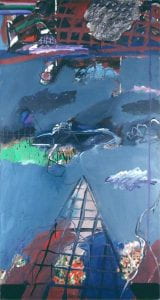
The North sea was in his mind, part of his discourse about what he was painting and where he was doing it. This painting links the sensuous experience of listening to music with proximity to that sea.
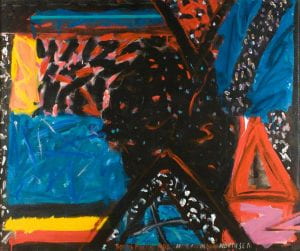
Places are defined by people. That seems to be common-sense, a self-evident truism. The place that is currently called ‘Edinburgh’ is, according to this view, ‘made’ by those who live and work and visit there. Although what about those who write about it from a distance, or who turn the place into a character in a film like ‘Trainspotting’?
This poster serves to ‘define’ Scotland as a place.
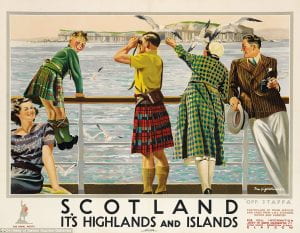
This place is seagulls, empty seas, lounging smiles and happy men in kilts. The creator of this image has contributed a load of value-ridden codswollop to the definition of the place.
And sticking with Edinburgh, doesn’t my experience of the city that I live in make me knowledgeable in a deeper way about Edinburgh than a person who has always lived in Dover or Eastbourne? If true, this suggests that the people are defined by the landscapes they inhabit.
Tim Ingold in his books, examines the cultural geography of place and space. One axiom is that to be is to know and to know is to be. Just as people define Scotland from what they know, so also do they define themselves from what is experienced by being in the place that is Scotland. Ingold writes about what he calls ‘the dwelling perspective’. Essentially, just as we live actively in a locality, the material existence of that locality impacts on us.
Standing at the edge then, facing the sea, a painter will experience the touch of the wind, the smell of the brine, the sound of the waves, the refracted light. To know this Scottish place is to be – in a very specific ‘Scottish’ way.